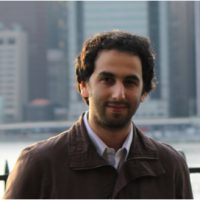Adriana Lleras-Muney in the Washington Post
Professor Adriana Lleras-Muney was quoted in the Washington Post in a story about the stagnating life expectancy in America. This article is based on a conference at the Brooking Institution.
Professor Adriana Lleras-Muney was quoted in the Washington Post in a story about the stagnating life expectancy in America. This article is based on a conference at the Brooking Institution.
Professor Michela Giorcelli was awarded the Cole Research Grants-in-Aid for post-Doctoral Research by the Economic History Association for her project on “The Marshall Plan and the European and US Economies After WWII”. The Cole Grants are annually awarded to recent Ph.D. recipients to support research in economic history.
2016 Robert D. & Margaret A. Wark Memorial Scholarship Recipient
Biography: Danwei Chen is a third-year student at UCLA pursuing a major in Economics and minor in Accounting. Having completed elementary through high school in Wisconsin, she is enjoying discovering all that Los Angeles has to offer. Danwei currently works for the Laurence and Lori Fink Center for Finance & Investments within the UCLA Anderson Graduate School of Management, where she has learned much about the finance industry. She is passionate about community involvement and serves as Vice President-Operations of Colleges Against Cancer at UCLA, the collegiate extension of the American Cancer Society. Danwei recently studied abroad at the London School of Economics, during which time she took courses in finance and economics and fostered her passions for travel and global cultures. She also likes to spend time hiking, playing/watching tennis, and trying new foods.
Future Plans: Danwei is excited about the applications of her education and is working towards a career in finance. This summer, she will be completing a Summer Analyst position at Pacific Alternative Asset Management Company in Irvine, California. She hopes to work full-time in the investment management field upon graduation and eventually pursue a Master’s in Business Administration.
What does the scholarship mean to me?: I feel incredibly honored to be selected as a recipient of the Robert D. and Margaret A. Wark Memorial Scholarship. I am extremely grateful to the Wark Family for their generosity in supporting my education. With this scholarship, I’m able to focus more time and effort on academic, professional, and extracurricular pursuits. I’m touched by the Wark Family’s giving values and hope to someday pay it forward to future generations of Bruins. In the meantime, I will strive to honor this recognition by continuing to work hard in the remainder of my time at UCLA and the start of my career.
The National Bureau of Economic Research featured Professor Till von Wachter in it’s biannual Bulletin on Aging and Health.

UCLA basketball center Tom Welsh and Economics major is named as PAC 12 All-Academic. Starting at 51:40, he talks about his favorite class (intermediate microeconomics!) and UCLA Basketball on the Bruin Insider show.
Venture capitalist Barry Eggers (BA ’85) is a member of our Board of Visitors, and frequent guest lecturer in Econ 106E and 106T. In this blog post he discusses how he discovered Snapchat five years ago, and went on to give them seed funding. Snapchat had its IPO yesterday.
Machine learning (ML) methods, developed mostly by computer scientists and statisticians, have brought remarkable success in solving prediction problems, especially with high-dimensional and complicated or, simply, big data. These methods have been used with great success, for example, in spam filtering and computer vision, among many other things.

In economics, however, prediction problems are of limited interest, and instead, the problem of measuring causal parameters, including various treatment effects, is much more important. Therefore, there has recently been an increasing amount of work in the econometrics literature trying to apply ML methods for estimation of causal parameters. One of the findings in this literature is that naively applying ML methods for estimation of causal parameters leads to unsatisfactory results: since ML methods are heavily regularized, ML-based causal parameter estimators are substantially biased, which leads to suboptimal precision of these estimators. Moreover, because of the bias, it is hard to study distributional properties of these estimators, which makes inference based on these estimators overly complicated.
In an attempt to overcome these difficulties, Denis Chetverikov (UCLA) has developed a novel method called Double Machine Learning (DML), in a joint project with Victor Chernozhukov (MIT), Mert Demirer (MIT), Esther Duflo (MIT), Christian Hansen (Chicago Booth), Whitney Newey (MIT), and James Robins (Harvard). This method is based on the observation that it is typically possible to represent the causal parameter of interest as a function of the solution of several prediction problems such that the bias in the solution of these prediction problems has minimal effect on the causal parameter itself. As long as such a function can be constructed, the DML method uses ML algorithms to solve each prediction problem separately in the first stage and then plugs in the solutions into the function giving the causal parameter of interest in the second stage. The authors show that by combining the DML method with a certain cross-fitting procedure, one can construct approximately unbiased and efficient estimators of the causal parameters, which have as high precision as possible, under very mild regularity conditions and allowing for a wide variety of ML methods to be used in the first stage. The authors also explain how the function relating the causal parameter and the solution of the prediction problems can be constructed in most commonly used econometric models via so-called Neyman orthogonal scores, which are extensively studied the literature on semiparametric estimation.
As an example illustrating the applicability of the DML method, the authors study the effect of institutions on economic growth following up on Acemoglu, Johnson, and Robinson (2001), “The colonial origins of comparative development: An empirical investigation,’’ American Economic Review. Estimating the effect of institutions on output is complicated by the clear potential for simultaneity between institutions and output: better institutions may lead to higher incomes, but higher incomes may also lead to the development of better institutions. To help overcome this simultaneity, AJR use mortality rates for early European settlers as an instrument for institution quality. The validity of this instrument hinges on the argument that (i) settlers set up better institutions in places where they are more likely to establish long-term settlements; (ii) where they are likely to settle for the long term is related to settler mortality at the time of initial colonization; and (iii) institutions are highly persistent. The exclusion restriction for the instrumental variable is then motivated by the argument that GDP, while persistent, is unlikely to be strongly influenced by mortality in the previous century, or earlier, except through institutions. AJR also note that their instrumental variable strategy will be invalidated if other factors are also highly persistent and related to the development of institutions and to the country’s GDP. A leading candidate for such a factor, as they discuss, is geography. AJR address this by assuming that the confounding effect of geography is adequately captured by a linear term in distance from the equator. However, if the true geography effect is non-linear, which can be expected, the AJR estimator may be substantially biased due to misspecification, and the DML method allows to overcome this problem by flexibly controlling for the geography effect. By applying the DML method to the AJR data, the authors confirm the AJR results that there is a substantial effect of institutions on country income, but the effect is smaller than reported by AJR. Moreover, the precision of the DML estimator is higher than that of the AJR estimator.
The paper can be found here.
By Bernardo S. Silveira

Pablo Fajgelbaum has been named as a 2017 Sloan Fellow, one of eight economists nationwide. Professor Fajgelbaum specializes in international trade. His recent research includes the distributional effects of international trade, the impact of regional tax policies, and optimal transport networks in general-equilibrium trade models. His teaches international trade theory at both undergraduate and graduate levels.
The official announcement is here.
In the second MAE Distinguished Speaker Lecture, Professor Richard Blundell of University College London talked about “Empirical Evidence and Tax Reform”
The lecture’s starting point was the Mirrlees Review that brought together a high-profile group of international experts to identify the characteristics of a good tax system for any developed economy in the 21st century. Professor Blundell described a broad set of descriptive statistics that are essential for understanding modern taxation, including male and female working patterns, the makeup of the modern welfare system and changes in inequality. Based on his recent research, he then discussed how one can estimate the impact of different programs, viewing the welfare and taxations systems as part of a unified system.
Sir Richard Blundell is the David Ricardo Professor of Political Economy at University College London. He is the Director of the Economic and Social Research Council (ESRC) Centre for the Microeconomic Analysis of Public Policy and of the Institute for Fiscal Studies, both in the United Kingdom. He has made lasting contributions to labor economics, public finance, and applied econometrics. His research covers the empirical microeconomic study of consumer behavior, savings, labor supply, taxation, welfare, innovation and inequality. Among other works, he has developed econometric methods for intertemporal decisions over labor supply, human capital and consumption, family labor supply behavior, dynamic panel data models, and nonparametric analysis of individual decisions.
Blundell is the recipient of many prestigious honors and awards including the Yrjö Jahnsson Prize (1995) for his work in microeconometrics and the analysis of labor supply, welfare reform and consumer behavior; the Econometric Society Frisch Prize Medal (2000) for the paper “Estimating Labor Supply Responses Using Tax Reforms;” the Jean-Jacques Laffont Prize (2008) given to a high-level economist whose research combines both the theoretical and applied aspects of economics; the CES-Ifo Prize (2010); the Sandmo Prize (2011); the IZA Prize in Labor Economics (2012); the BBVA Foundation Frontiers of Knowledge Prize in Economics (2015); and the Erwin Plein Nemmers Economics Prize (2016). He was knighted in the 2014 Queens New Years Honours list for his services to Economics and Social Science.
He has served as president of the European Economics Association, the Econometric Society, the Society of Labor Economics and the Royal Economic Society. He is a fellow of the Econometric Society, the British Academy and the Institute of Actuaries and an Honorary Member of the American Economic Association and the American Academy of Arts and Sciences.

UCLA Department of Economics
